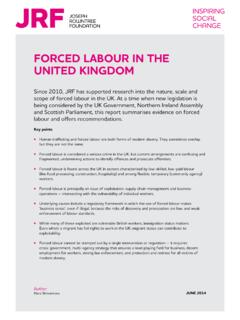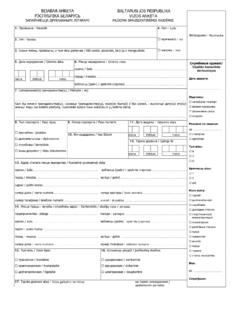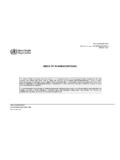Transcription of Forced labour in the United Kingdom
1 1 Forced labour IN THE United KINGDOMS ince 2010, JRF has supported research into the nature, scale and scope of Forced labour in the UK. At a time when new legislation is being considered by the UK Government, Northern Ireland Assembly and Scottish Parliament, this report summarises evidence on Forced labour and offers pointsHuman trafficking and Forced labour are both forms of modern slavery. They sometimes overlap but they are not the labour is considered a serious crime in the UK, but current arrangements are confusing and fragmented, undermining actions to identify offences and prosecute offenders. Forced labour is found across the UK in sectors characterised by low-skilled, low-paid labour (like food processing, construction, hospitality) and among flexible, temporary (commonly agency) workers. Forced labour is principally an issue of exploitation, supply chain management and business operations intersecting with the vulnerability of individual workers.
2 Underlying causes include a regulatory framework in which the use of Forced labour makes business sense , even if illegal, because the risks of discovery and prosecution are low, and weak enforcement of labour standards. While many of those exploited are vulnerable British workers, immigration status matters. Even where a migrant has full rights to work in the UK, migrant status can contribute to labour cannot be stamped out by a single intervention or regulation it requires cross-government, multi-agency strategy that ensures a level playing field for business, decent employment for workers, strong law enforcement, and protection and redress for all victims of modern 2014 AuthorKlara Skrivankova2 INTRODUCTIONA Modern Slavery Bill was introduced to the UK parliament in June 2014, building on the work of the Modern Day Slavery Bill Evidence Review (2013) and the Joint Committee on the Draft Modern Slavery Bill report (2014). In Northern Ireland, a private members bill to firm up trafficking laws was introduced by Lord Morrow in 2013 (now to be integrated into a consolidated bill) and the Department of Justice has issued an updated Action Plan on Human Trafficking and Exploitation for 2014/15.
3 In Scotland, ministers have announced their intention to introduce a consolidated law. Forced labour is a serious crime and a form of modern slavery estimated by JRF to currently affect at least 3,000 to 5,000 people across the UK. It is defined by the International labour Organization (ILO) as any work or service exacted under the menace of any penalty, and for which the worker has not offered himself voluntarily . Forced labour lies at the end of a continuum between decent work (being the optimum) and Forced labour (being the most severe form of labour exploitation). It is caused by a number of factors, but the core drivers are:the interaction between an individual s vulnerability and a setting in which this individual s work or services can be exploited for profit without too much risk of discovery or prosecution;the economic drivers for Forced labour practices to be used in the UK, especially in labour supply chains;the regulatory framework within which the use of Forced labour and exploitation of workers makes business sense, even if the number of detected cases is increasing, Forced labour remains underreported.
4 This is due to inadequate data collection, reluctance of those affected to come forward and lack of awareness among police and other frontline agencies about the indicators. Forced labour is already considered a serious crime in the UK. In 2009, a standalone offence of holding a person in slavery, servitude or Forced labour was included in section 71 of the Coroners and Justice Act. However, present legislative arrangements on Forced labour and human trafficking are confusing and fragmented, undermining actions to identify offences and prosecute offenders. Evidence of Forced labour in the UKWhat is Forced labour ? Forced labour Convention (1930) of the ILO defines Forced labour as: Any work or service exacted under the menace of any penalty, and for which the worker has not offered himself voluntarily. To better understand what Forced labour constitutes in practice, the ILO initially developed a list of six Forced labour indicators:threats or actual physical harm to the worker; restriction of movement or confinement to the workplace; debt bondages; withholding of wages or excessive wage reductions; retention of identity documents; threat of denunciations to the authorities.
5 3 The ILO developed longer lists of situations and conditions that constitute abuse. This approach was further developed in the JRF research to identify Forced labour practices in the UK, which included:Upfront fees/debt bondage: Many workers paid fees to agents, either for travel to the UK or for job arrangements. This often led to indebtedness that created a bond with exploitative work or tied the worker to accommodation. This was found to be a common practice despite the fact that charging for finding or trying to find work is not permitted in the and bullying: This was often linked to racism experienced by migrant workers or differential treatment to British through dismissal: The research found three main forms: to avoid paying workers wages; to punish workers for refusing to work overtime; when workers became ill or pregnant. Productivity targets and surveillance: This includes constant monitoring or imposing unrealistic production researchResearch supported by JRF s Forced labour programme represents a comprehensive collection of independent studies on Forced labour , including research into business models and supply chains, specific industries and locations, and experiences of labour exploitation (all research published by JRF and available to download from ):Allain, J.
6 , Crane, A., LeBaron, G. and Behbahani, L. (2013) Forced labour s business models and supply chains Clark, N. (2013) Detecting and tackling Forced labour in EuropeDugan, E. (2013) Forced labour and human trafficking: Media coverage in 2012 Dwyer, P. Lewis, H., Scullion, L. and Waite, L. (2011) Forced labour and UK immigration policy: Status matters? Geddes, A., Craig, G., Scott, S., Ackers, L., Robinson, O. and Scullion, D. (2013) Forced labour in the UKJarman, N. (2014) Forced labour in Northern Ireland: An updateJarman, N., Allamby, L., Bell, J., Hamilton, J., Hansson, U., Potter, M. and Toma, S. (2011) Forced labour in Northern Ireland: Exploiting vulnerabilityKagan, C. Lo, S., Mok, L., Lawthom, R., Sham, S., Greenwood, M. and Baines, S. (2011) Experiences of Forced labour among Chinese migrant workersLalani, M. and Metcalf, H. (2012) Forced labour in the UK: The business angle Balch, A. (2012) Regulation and enforcement to tackle Forced labour in the UK: A systematic response?
7 Lo, S., Lawthom, R. and Kagan, C. (2011) Chinese migrants: Their experiences in their own words Scott, S., Craig, G. and Geddes, A. (2012) Experiences of Forced labour in the UK food industry Skrivankova, K. (2010) Between decent work and Forced labour : Examining the continuum of exploitation4 Overwork: This indicator applied especially to agriculture workers in the peak of the season and to Chinese workers in the catering sector where work intensity prevented them from developing any meaningful life outside of wages: Some discrepancy in pay was found in the majority of cases of labour exploitation. Migrants were often unable to get the pay that they were owed or were promised to be paid later, and pay day was constantly : Migrants were commonly charged for job arrangement services or were subject to deductions for equipment, clothing and so on. Non-payment of these charges would result in the worker being denied work. Tie-ins (work authorisation): Since a work permit is de facto tied to a particular employer (because of the requirement of an employer sponsor), it is difficult for a worker to change job.
8 The misbalance of power between employer and worker can lead to (accommodation): Exploitative work is often linked to sub-standard accommodation that comes with the job, whereby the worker has no choice of accommodation and the housing provided is overcrowded, poor quality and overpriced. Refusal of the provided accommodation can lead to loss of (money): Some employers kept workers pay for safekeeping , but denied the workers regular access to their money, purposefully creating a situation of on the definition and indicators of Forced labour , reflecting ILO guidance, is required for it to be tackled effectively by the UK government and devolved administrations, public authorities including local authorities, the police and the judiciary, and relevant non-governmental does Forced labour relate to human trafficking? Forced labour and human trafficking are not the same, although they sometimes overlap. For this reason, they should be dealt with separately in policy and in practice.
9 Human trafficking is a process of bringing someone into a situation of exploitation. It is a series of connected actions with the final purpose being a form of exploitation (such as labour or sexual exploitation). The whole process is exploitative, although this is not always evident, especially at the initial stages. The overlap occurs where labour exploitation is the intended purpose of human trafficking. In summary, human trafficking is a sub-set of Forced labour it is not a synonym. Figure 1: Continuum of exploitation and interventions DECENTWORKFORCEDLABOURS phere of mixedinterventionsSphere of labour law interventionSphere of criminal lawinterventionNON-TRAFFICKINGTRAFFICKIN GPROCESSF igure 2: Employment relationshipLabour supplier/agent WorkerLabour user/employer 5A continuum from decent work to Forced labourForced labour is a distorted employment relationship where a worker is subjected to severe exploitation either by their direct employer or by an intermediary such as a gangmaster.
10 Legal definitions describe the acts of exploitation that constitute breaches of law, but the reality is often more complex. Skrivankova (2010) developed the continuum of exploitation to understand and address the complex reality of Forced labour and labour exploitation and identify the range of remedies at hand. This concept addresses both the symptoms and the causes and brings in labour law and enforcement of labour rights alongside criminal justice interventions. The continuum is a model reflecting the real-life experiences of workers. Employment relationships are not static; an individual s work situation changes over time. The model takes into account the variability in an individual s working conditions that results from the circumstances of the worker (economic, social), their personal vulnerabilities (mental health, addictions), as well as external pressures (immigration regulations, economic climate). These pressures affect the choices that workers make, or that are open to them, and on the behaviour of employers.







